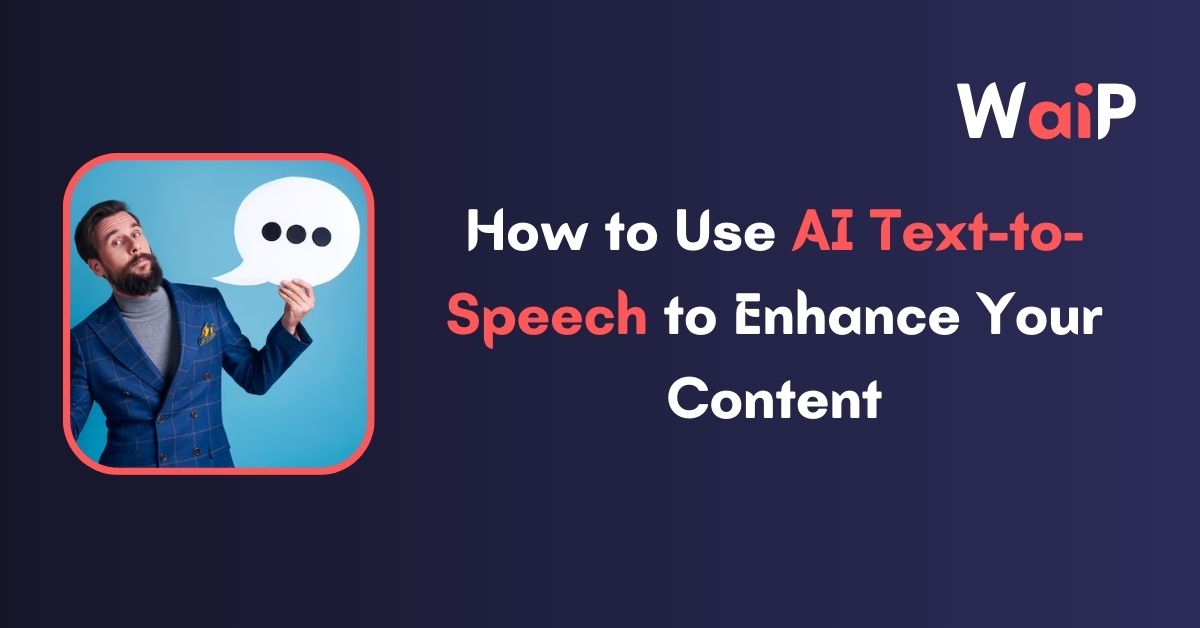Turning written words into spoken words using artificial intelligence (AI), or Text-to-Speech (TTS) technology, is getting better and simpler. For anyone creating content, this is fantastic as it can significantly enrich your material.
In this post, we’ll guide you on how to elevate your content in 2023 using AI TTS.
The Basics of AI Text-to-Speech
AI TTS takes written words, breaks them down, and uses AI to transform them into spoken sounds. The technology has advanced remarkably, and the resulting speech is often so good it’s hard to tell it from a human voice.
To Pick a Perfect AI Text-to-Speech Tool, With numerous AI TTS tools out there, you’ll want to choose the best one for your needs. Consider the quality of the speech, available voices and accents, customization options, ease of use, and cost.
Steps to Use AI Text-to-Speech
Step 1: Pick an AI voice generator
There are many AI programs that can turn text into spoken words. To pick the right one for you, consider:
- Sound quality: Does the voice sound clear and natural?
- Voice options: Do you want many different voices to choose from, or just one?
- Cost: How much money are you willing to pay for this service?
After thinking about these points, you can pick your favorite tool. Here are three to start with:
- Google Text-to-Speech: This is a free tool with many voices in different languages.
- Amazon Polly: This tool isn’t free, but the voices sound very good. It also has many voices to choose from.
- Natural Reader: This tool isn’t free, but it has a lot of features. You can change how fast the voice talks, how high or low it sounds, and how loud it is.
Step 2: Type or paste your text
When you’ve picked your tool, type or paste your text into it. The tool will then change your text into spoken words.
Step 3: Pick a voice
Most tools let you pick from many voices. Choose a voice that fits your topic or your listeners’ preferences.
For example, if you’re explaining a new recipe, you might want a voice that sounds friendly. If you’re making a voiceover for a sales video, you might want a voice that sounds confident.
Step 4: Change the settings
Some tools let you change how the voice sounds. You can try different speeds, pitches, and volumes to find the best sound.
For example, if you’re turning a blog post into spoken words, you might want the voice to speak slowly. This way, listeners can understand everything. If you’re making a voiceover for a sales video, you might want the voice to sound lively.
Step 5: Listen to the voice
After you’ve made these changes, listen to the voice. You can save the voice recording to use later. Listen closely to make sure all the words are pronounced right. Check for any mistakes.
Upsides and Downsides of AI Text-to-Speech
AI TTS brings plenty of benefits, like making content more accessible for visually impaired people, making it more engaging, and helping to produce various types of content.
However, there are potential downsides. The speech might not sound as natural as a human voice, it might mispronounce words because it doesn’t understand the context, and it may not support all accents and languages.
Fine-Tuning AI Voices for Better Content
One of the perks of AI TTS is that you can adjust the voices to fit your content. Depending on your content, you might want a playful, engaging voice, or a professional, authoritative one. You can often adjust pitch, tone, speed, accents, and languages.
AI Text-to-Speech’s Effect on Different Content Types
AI TTS can elevate many content types:
- Audiobooks: It can convert text into audiobooks, useful for visually impaired individuals or those who prefer listening to reading.
- Voiceovers: It can produce voiceovers for videos, presentations, and more, enhancing engagement.
- Educational content: It can create engaging, accessible educational content, like interactive lessons and gamified apps.
- Marketing content: It can create engaging product descriptions and pitches.
- Customer service: It can be used to create customer service bots, providing round-the-clock support.
Top 5 AI Text-to-Speech Generators of 2023
There are many AI TTS generators, but some of the best are:
- Lovo AI: A user-friendly, affordable option with a wide range of voices and accents.
- Resemble AI: Offers extensive customization and many features, but it’s pricier than Lovo AI.
- Natural Reader: A free, budget-friendly option with a limited number of voices and accents.
- Google Text-to-Speech: A free option available as a Chrome extension, good for those wanting in-browser use.
- Amazon Polly: A cloud-based, feature-rich option that offers a variety of voices and accents, though it’s pricier than some others.
Real-World Success Stories of AI Text-to-Speech
AI TTS is already seeing practical use:
- Increasing accessibility: The National Library of Australia, for instance, uses AI TTS to transform books into audiobooks for visually impaired people.
- Creating educational content: The Khan Academy uses AI TTS for voiceovers in its educational videos.
- Enhancing customer service: Some businesses use AI TTS to create chatbots, providing a more natural and engaging customer service experience.
Tips to Make the Most of AI Text-to-Speech Tools
- Choose the right voice: The voice you choose can significantly influence your content’s effectiveness, so pick one that matches your content’s tone and your audience’s expectations.
- Customize settings: AI TTS tools often provide adjustable settings for perfecting the speech sound.
- Combine with other tools: You can pair AI TTS with other tools to create even more compelling content, such as video voiceovers or interactive learning modules.
- Test your content: Always test your content to ensure it sounds natural and engaging.
The Future of AI Text-to-Speech
The future looks bright for AI TTS. As AI continues to evolve, we can expect AI TTS tools to become more advanced and the speech quality to improve. We may see it being used in new ways, like creating personalized audiobooks, generating real-time video captions, or creating interactive virtual assistants.
Conclusion
AI TTS is a potent tool that can significantly enhance your content in numerous ways. By using the tips in this guide, you can make your content more accessible, engaging, and informative. If you have any questions, don’t hesitate to drop a comment below.
FAQs: How to Use AI Text-to-Speech
What is AI Text-to-Speech (TTS)?
AI TTS is technology that transforms written words into spoken sounds. The quality of the resulting speech has improved significantly, often sounding human-like.
What factors should I consider when choosing an AI TTS tool?
Key considerations include the quality of speech, available voices and accents, customization options, ease of use, and cost.
What are the benefits and downsides of AI TTS?
AI TTS makes content more accessible, engaging, and versatile. However, it might not sound as natural as human speech, could mispronounce words, and might not support all accents/languages.
How can AI TTS be fine-tuned for better content?
AI TTS can be adjusted to match the tone of your content. Pitch, tone, speed, accents, and languages can often be modified for an optimal voice.
What future developments can we expect in AI TTS?
As AI evolves, AI TTS tools will likely become more advanced, offer improved speech quality, and could be used in new ways like generating real-time video captions or creating interactive virtual assistants.

![Best Mobile Games Your Should Try in 2024 [Trending Now] 2 Best Mobile Games](https://wideaiprompts.com/wp-content/uploads/2024/03/Best-Mobile-Games-330x220.webp)



![Best Mobile Games Your Should Try in 2024 [Trending Now] 9 Best Mobile Games](https://wideaiprompts.com/wp-content/uploads/2024/03/Best-Mobile-Games-150x150.webp)


